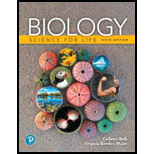
Pearson eText Biology: Science for Life -- Instant Access (Pearson+)
6th Edition
ISBN: 9780135214084
Author: Colleen Belk, Virginia Maier
Publisher: PEARSON+
expand_more
expand_more
format_list_bulleted
Concept explainers
Question
Chapter 15, Problem 2LTB
Summary Introduction
To explain:
An expected decrease in population growth as a non-human population approaches
Introduction:
The carrying capacity is the highest population that an environment can sustain when are no limits to its resources. Although populations tend to grow exponentially, their growth is constrained by the resources needed for their survival and reproduction.
Expert Solution & Answer
Want to see the full answer?
Check out a sample textbook solution
Students have asked these similar questions
Population growth that is dependent on the number of individuals
A. Arithmetic Growth
B. Carrying Capacity
C. Intrinsic Rate of Growth
D. Exponential Growth
A population is expected to grow exponentially
when the population size is close but below the carrying capacity of the
environment.
when the population size is exceeding the carrying capacity of the environment.
when the birth rate changes as a function of the population
after a severe population bottleneck.
Distinguish between the exponential and logistic growth of a population and describe the nature of their growth curves. Define environmental resistance. What is the carrying capacity of an environment? Define and give an example of a population crash.
Chapter 15 Solutions
Pearson eText Biology: Science for Life -- Instant Access (Pearson+)
Ch. 15 - Prob. 1LTBCh. 15 - Prob. 2LTBCh. 15 - Prob. 3LTBCh. 15 - Prob. 4LTBCh. 15 - According to the graph shown here, the carrying...Ch. 15 - All of the following are density-dependent factors...Ch. 15 - In contrast to nonhuman populations, human...Ch. 15 - Populations that rely on stored resources are...Ch. 15 - The current carrying capacity of Earth for the...Ch. 15 - Prob. 10LTB
Knowledge Booster
Learn more about
Need a deep-dive on the concept behind this application? Look no further. Learn more about this topic, biology and related others by exploring similar questions and additional content below.Similar questions
- A human population of 10,000 individuals has a birth rate of 90 per every 1000 persons and a death rate of 16 per every 1000 individuals. Calculate the yearly increase of the population growth. a) 740 individuals/year b) 74 individuals/year c) 10,074 individuals/year d) 11,074 individuals/yeararrow_forwardWhere is the growth rate the fastest on a logistic growth curve? at the inflection point in the very beginning when the population is small right before it reaches the carrying capacityarrow_forwardCompare and contrast ‘bottom up’ versus ‘top down’ factors that limit population growth.arrow_forward
- A population is expected to grow exponentially after a severe population bottleneck. when the population size is exceeding the carrying capacity of the environment. when the population size is close but below the carrying capacity of the environment. when the birth rate changes as a function of the populationarrow_forwardDescribe the historical pattern of growth of the worldwide human population since our origin. Include in this historic overview the changes that have happened technologically, medically, culturally and nutritionally to result in major population changes over time. Relate the growth of the human population to our ecological footprint and explain the idea of limits to population growth known as the carrying capacity. Relative to carrying capacity, what may result from unbridled continued growth of our population? How does the size of the human population contribute to environmental degradation? Why must we take the human population size into account when we attempt to develop environmental restoration projects? - minimum word count 1,500arrow_forwardPopulation growth that adds the same number each year A. Arithmetic Growth B. Carrying Capacity C. Intrinsic Rate of Growth D. Exponential Growtharrow_forward
- Which of the following is true of a population approaching its carrying capacity? a) The population’s emigration is greater than its immigration. b) The population has access to unlimited resources. c) Intraspecific competition decreases. d) The population’s rate of increase approaches zero.arrow_forwardDraw a graph with a growth curve for a population that starts at 10 individuals and experiences exponential growth. Draw a second graph with a growth curve for a population that starts with 10 individuals and undergoes logistic growth. The second graph should have a carrying capacity of 100 individuals. Please give a proper written explanation for the graphs.arrow_forwardSelect the density-dependent factors that can affect population growth rates from the options provided. volcanic eruption tsunami disease predation competition temperaturearrow_forward
- in 2021, the growth rate of the human population was 1.03% per year with a thencurrent population of 7.875 billion people. Assuming a carrying capacity of 15 billionindividuals,when will the population reach 14.5 billion (i.e., nearly carrying capacity)?arrow_forwardDo the questions below the mosquito pleasearrow_forwardDescribe the exponential model of population growth give the characteristics of species that follow this model of population growth.arrow_forward
arrow_back_ios
SEE MORE QUESTIONS
arrow_forward_ios
Recommended textbooks for you
 Biology (MindTap Course List)BiologyISBN:9781337392938Author:Eldra Solomon, Charles Martin, Diana W. Martin, Linda R. BergPublisher:Cengage Learning
Biology (MindTap Course List)BiologyISBN:9781337392938Author:Eldra Solomon, Charles Martin, Diana W. Martin, Linda R. BergPublisher:Cengage Learning Concepts of BiologyBiologyISBN:9781938168116Author:Samantha Fowler, Rebecca Roush, James WisePublisher:OpenStax College
Concepts of BiologyBiologyISBN:9781938168116Author:Samantha Fowler, Rebecca Roush, James WisePublisher:OpenStax College
 Biology Today and Tomorrow without Physiology (Mi...BiologyISBN:9781305117396Author:Cecie Starr, Christine Evers, Lisa StarrPublisher:Cengage Learning
Biology Today and Tomorrow without Physiology (Mi...BiologyISBN:9781305117396Author:Cecie Starr, Christine Evers, Lisa StarrPublisher:Cengage Learning

Biology (MindTap Course List)
Biology
ISBN:9781337392938
Author:Eldra Solomon, Charles Martin, Diana W. Martin, Linda R. Berg
Publisher:Cengage Learning

Concepts of Biology
Biology
ISBN:9781938168116
Author:Samantha Fowler, Rebecca Roush, James Wise
Publisher:OpenStax College


Biology Today and Tomorrow without Physiology (Mi...
Biology
ISBN:9781305117396
Author:Cecie Starr, Christine Evers, Lisa Starr
Publisher:Cengage Learning
Ecology: Interspecific and Intraspecific Interactions | Ecology & Environment | Biology | FuseSchool; Author: FuseSchool - Global Education;https://www.youtube.com/watch?v=IiQTrA0-TE8;License: Standard YouTube License, CC-BY